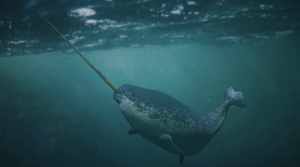By Marguerite Holloway
Late one August evening three summers ago in Fønfjord, a fifty-mile-long channel in Scoresby Sound, East Greenland, two narwhals were netted by local hunters and towed into the shallow waters off Hjørnedal, a small field station. The Arctic night a thousand or so miles from the North Pole is not entirely dark in late summer, but the Hjørnedal team—Inuit narwhal hunters collaborating with a group of researchers—needed headlamps. As quickly as they could, they untangled the narwhals and fitted each with a heart-rate monitor, a satellite transmitter, and a listening device called an Acousonde. The misshapen right pectoral fin and scars on the mottled many-shades-of-gray skin of one narwhal looked familiar. The team recognized Nemo, a young male with a modest thirty-two-inch tusk, first caught in 2014.
Within thirty minutes of capture, the abundantly instrumented Nemo swam back toward Fønfjord. He dived a few times, presumably to the bottom of the Hjørnedal bay, where he dislodged the suction cups that fastened the heart-rate recorder to his back, a maneuver he had perfected four years earlier. He swam north into Rødefjord—a thirty-mile-long fjord as broad as a small sea and, in August, traversed by thousands of icebergs, many echoing the shapes of the mountains where they originated.
For hours, Nemo didn’t make a sound, as is true of most narwhals after catch and release. He never went much below three hundred and twenty feet (narwhal travelling depth) until, at three o’clock in the morning, he dived eight hundred and twenty feet or so (nearing narwhal feeding depth) and clicked. Narwhals can make as many as a thousand clicks every second, and emit them in a wide or narrow beam of sound that returns an aural portrait of shapes and distances at some of the highest resolutions known for animals. Such resolution is vital in winter darkness and dense pack ice, where cracks or holes, portals to air, open in less than three per cent of the frozen sea. Nemo dived to two thousand feet, where there is no light, the water is on the cusp of freezing, and there is prey, likely squid, halibut, capelin, and polar cod. Nemo’s clicks and buzzes indicated that he was hunting. Soon after, he made his signature call: a short series of clicks, also called a burst pulse, followed by a high-pitched whistle, repeated in sequence. (Each narwhal has its own particular vocalization, and, although the calls are thought to be social, their exact role is unclear.)
Life for Nemo was back to narwhal normal—calling and hunting and eating—until a little after six the following morning, when he heard sounds that were not the familiar rush of submarine currents from melting glaciers, the wind making waves, the earthquake-like rumble of calving ice sheets, the loud report of an iceberg cracking, nor the thunder of one flipping. Rounding the tip of Milne Land, the largest island in Scoresby Sound, was the Royal Danish Navy vessel Lauge Koch. On board was the seafaring half of the Hjørnedal research team. They were making a racket, on purpose. In addition to incidental noise from the engine and the pinging of the ship’s side-scan sonar, a seismic air gun issued a loud underwater blast—producing a sound like a detonation—every eighty seconds.
Nemo stopped buzzing. He swam toward the surface, where he could breathe as often as he liked, and he raced away. The water rushed past the Acousonde, the listening device still fastened to his back by suction cups and a magnesium coupler that slowly dissolves in salt water. “He is swimming so fast, he is stroking so fast, I cannot hear anything,” Susanna Blackwell, a marine-mammal-acoustics expert with Greeneridge Sciences who was aboard the Lauge Koch, said. “He is Mr. Freak Out.” For roughly twenty-four hours after hearing the ship and the air gun, Nemo did not vocalize or, perhaps critically, hunt or eat. An experiment with a single, comparatively small air gun—less powerful than those often used simultaneously with dozens of others during oil-and-gas exploration—had stressed out one of the Arctic’s most elusive creatures.
Much of the marine world has become loud like a perpetually congested highway, thick with motors and horns and sirens. Comparatively, the Arctic has been like the countryside, as Blackwell, the acoustic lead on the Hjørnedal team, told me—with the occasional lawnmower or leaf blower. By and large, she said, the region “has been protected from industrial noise in a way that no other place on the planet has been.” But, as sea ice rapidly diminishes in extent and duration, the Arctic is losing its sound-attenuating cover of ice, and vessel traffic is increasing as shipping routes open and resource exploration amps up. “For many reasons, the problems are compounded in the Arctic, because it has been so isolated for so long,” Blackwell said.
The problems are extensive. In the past fifty years, the oceans have become vastly noisier as a result of, among other things, boat and ship engines (there are some ninety thousand merchant vessels alone), seismic surveys for fossil fuels, military sonar, and blasting for mining and for oil-rig and wind-farm construction. Comparisons between sound levels in water and in air are challenging, as are comparisons between what animals hear and how people would experience something similar. Even so, a container ship to a whale may sound like a speaker-proximal seat at a rock concert—and though the fan has chosen to be that close to the clamor, the whale has not. Noise can travel in water more than four times faster than it does in air, and can reach for hundreds and sometimes a few thousand miles, depending on the source and frequency of the sound and the qualities of the water column—namely its temperature and salinity.
Much of the increase is in low-frequency noise, the frequency band that many marine mammals, baleen whales in particular, use to find mates and their offspring, to hunt, and to share information. “That is a very worrisome trend, of course, because that means that these long-distance communicators can’t hear each other any longer,” Blackwell said. She has spent a decade studying bowhead whales in the Beaufort Sea, part of the Arctic Ocean north of Alaska, and estimated that she has analyzed several million bowhead calls. At low doses of air-gun sound, the bowheads called more often, perhaps trying to insure that their messages were heard. When the source of noise was closer and the air-gun pulses were louder, the whales stopped calling. At some point, Blackwell and her colleagues concluded, the whales may have found that calling—to communicate about location or food, to find mates or calves—was no longer worth the effort, because it had become too difficult to decipher the information in the call.
In addition to disrupting communication, background and short-term noise have been linked in whales to stress responses (which can impair immune-system and reproductive health), to fatal strandings, and to population declines. More than a hundred studies have also documented adverse effects on cephalopods, fish, and other organisms. In 2018, Lindy Weilgart, a marine-noise-pollution expert at Dalhousie University and OceanCare, a conservation organization, did a review of all related studies. She found that noise appears to be disruptive to nearly every creature studied so far. In fish, it can impair reproduction and disrupt schooling and other important behaviors, such as avoiding predators. Loud noise can flat out kill zooplankton, tiny creatures that help support the global marine-food web.
But how narwhals respond to the cacophony attending human marine activity has been unknown. Assessing those impacts for the northernmost-ranging cetacean is important to formulating shipping, mining, and seismic guidelines and regulations as the region becomes a thoroughfare. By the most recent estimate, around a hundred thousand narwhals currently exist, most of them in Canada and Greenland. In the nineties, regulators approached some expert Arctic biologists for guidance. “We were being asked to come up with advice on how to avoid disturbing the marine animals,” Mads Peter Heide-Jørgensen, a professor at the Greenland Institute of Natural Resources and the University of Copenhagen, and the leader of the Hjørnedal team, said. Because Scoresby Sound, on Greenland’s least populated coast, had experienced scant human noise, it seemed an ideal place to study anthropogenic acoustic impacts on narwhals. “A good little aquarium, so to speak, where we were under controlled conditions,” Heide-Jørgensen said.
Source: https://www.newyorker.com/science/elements/the-acoustic-lives-of-narwhals








